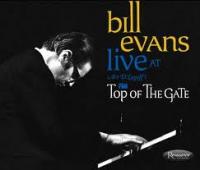Thank you for posting this. I almost forgot this was coming. I had grabbed the pre-release 10"of this on record store day, nice music.
Bill Evans Live Set Issued For First Time
Incredibly, most of them have been issued on high quality vinyl as well as on CD. These include John Coltrane, One Down, One Up Live at the Half Note (Impulse B0002380-01 2LPs), The Complete Thelonious Monk at The It Club (Mosaic MRLP 3001 4 LPs) and Thelonious Monk Quartet with John Coltrane at Carnegie Hall (Mosaic Records Thelonius Records MQ1-231). None are throwaways and all sound surprisingly good. (Search this site for reviews).
Now comes this Bill Evans set, recorded in 1968 by then 22 year old George Klabin, Director of Jazz Programming at Columbia University’s WKCR-FM.
He’d gotten permission to record the set and broadcast it once, from Evans’ manager Helen Keane, who, he now surmises wanted to use it as a demo for the new trio Evans had assembled.
So, on October 23rd, 1968 Klabin schlepped his Crown R2R two-track 15 IPS tape recorder, Ampex 4 channel tube mixer and four microphones (Neumann U67, Beyer dynamic, Sennheiser condenser and Electro-Voice dynamic) to “Art D’Lugoff’s The Top of the Gate,” a relatively large L-shaped space that was more steak house than night club. The famed Village Gate was actually downstairs.
Upstairs, diners could eat and talk, oblivious to the “background music” provided by the likes of Evans, Thelonious Monk and others. Those interested in listening could sit at smaller café-sized tables or at the bar, where the $3.00 cover charge was waived. Yes, it was a very different time!
While Evans and his new trio with Eddie Gomez on bass (he’d remain with Evans for more than a decade) and Marty Morell on drums (he stayed with Evans for seven years) played upstairs, the double bill of The Thelonious Monk Quartet and The Charles Lloyd Quartet played downstairs.
Klabin was faced with a less than ideal recording situation. The room was filled with people talking but since he preferred close miking in the first place, he was able to filter out almost the entire crowd, which can only be heard on a few occasions way in the background. Of course at the end of each piece, those gathered close to the stage can easily be heard clapping.
Klabin put the Neumann mike center stage close to Evans’ piano, the Sennheiser and Beyer on the drums and the Electro-voice wrapped in foam and placed directly on the bridge of the bass.
Perhaps because of the setting, or the new trio, this is a higher energy, far less introspective sounding performance compared to the classic Village Vanguard recordings, though no less lyrical. In fact, this piece was almost titled “Evans on Fire,” so animated are all three musicians and so fast paced are the readings of many familiar tunes.
As with previous Evans trios, the bassist had far more to do than keep time. Gomez staked out melodic, improvisational territory, much as the late Scotty LaFaro had before him and though he was new to the group, there was nothing tentative or cautious about his playing on this set.
The sound here is remarkably fine, considering the conditions under which the engineer worked: no sound check to get levels balanced. Just hit “record” and hope for the best as the group begins to play and adjust accordingly. You can hear Klabin do just that after the first few songs, where the drums and bass are up somewhat high in the mix.
The overall tonal balance is on the warm, somewhat muted side with transients less than fully expressed, but that’s more than made up for by superb instrumental textures and overall intimacy thanks to the close miking. You lose room space, but gain instrumental body. Played at the appropriate level, you'll almost feel as if you're onstage.
The 3 45rpm LP/2CD set includes all 17 songs performed during the two sets that evening, including a few duplicates. Other than one Evans original, “Turn Out the Stars,” the sets were filled with familiar standards like “My Funny Valentine,” “Witchcraft,” “Emily,” “In a Sentimental Mood,” “Autumn Leaves,” “’Round Midnight” and the then relatively new “Alfie.”
The 3 LPs mastered by Bernie Grundman and pressed at RTI yield the obvious high quality results (though since the credits include "sound restoration" and "mastering by Fran Gala" it's unclear whether or not the analog tapes or digital files were used for the lacquer cutting) and the full color, full sized glossy four pane insert contains essays by Nat Hentoff, Gary Burton engineer Klabin and D’Lugoff’s son Raphael that fill in the blanks to produce a complete picture.
The nimble touches all around and fast pacing throughout make this a lighter than air experience—one that’s consistently buoyant but never frothy or light weight. Highly recommended for Evans fans who will treasure that something this musically significant unexpectedly shows up all these years later.
- Log in or register to post comments

I always wonder, why such valuable but really not at all top range sounding releases are done at 45 RPM. Do you think this has any advantage over 33 RPM in this case?
Do they make more money selling more vinyl with a release?

and they said the Lugoff was the only of their Evans LP’s using the analog master.





